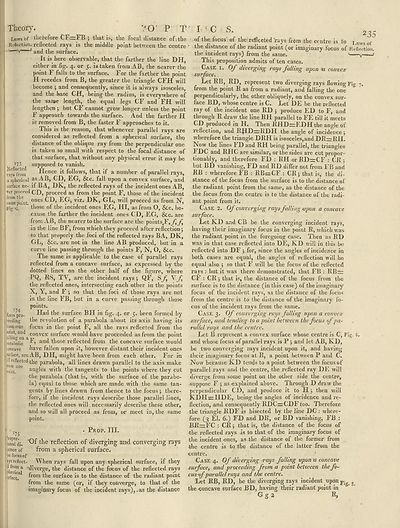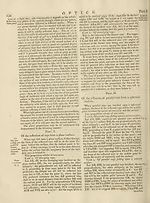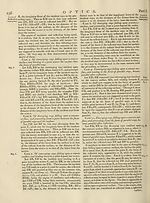Encyclopaedia Britannica > Volume 15, NIC-PAR
(255) Page 235
Download files
Complete book:
Individual page:
Thumbnail gallery: Grid view | List view

?o P f
Laws of therefore CF—FB ; tliat is-, the focal distance of, the
Reflection, reflected rays is the middle point between the centre
and the surface.
It is here observable, that the farther the line DH,
either in fig. 4. or 5. is taken from AB, the nearer the
point F falls to the surface. For the farther the point
H recedes from. B, the greater the triangle CFH will
become ; and consequently, since it is always isosceles,
and the base CH, being the radius, is everywhere of
the same length, the equal legs CF and FH will
lengthen j but CF cannot grow longer unless the point
F approach towards the surface. And the farther H
is removed from B, the faster F approaches to it.
This is the reason, that whenever parallel rays are
considered as reflected from a spherical surface, tliQ
distance of the oblique ray from the perpendicular one
is taken so small with respect to the focal distance of
that surface, that without any physical error it may be
J73 supposed to vanish.
'ays from Hence it follows, that if a number of parallel rays,
a spherical as CD, EG, &c. fall upon a convex surface, and
surface ne- if BA, DK, the reflected rays of the incident ones AB,
ver proceed CD, proceed as from the point F, those of the incident
same point.
I c s.
235
t'iir <5.
x74
lays pro-
leedini;
ones CD, EG, viz. DK, GL, will proceed as from N,
those of the incident ones EG, HI, as from O, &c. be¬
cause the farther the incident ones CD, EG, &c. are
from AB, the nearer to the surface are the points^F, f f
in the line BF, from which they proceed after reflection j
so that properly the foci of the reflected rays BA, DK,
GL, &c. are not in the line AB produced, but in a
curve line passing through the points F, N, O, &c.
The same is applicable to the case of parallel rays
reflected from a concave surface, as expressed by the
dotted lines on the other half of the figure, where
PQ, RS, TV, are the incident rays-, QF, V f
the reflected ones, intersecting each other in the points
X, Y, and F ; so that the foci of those rays are not
in the line FB, but in a curve passing through those
points.
Had the surface BH in fig. 4. or 5. been formed by
the revolution of a parabola about its axis having its
focus in the point F, all the rays reflected from the
2-d . convex surface would have proceeded as from the point
wrabolic ^ ’ aiv^ those reflected from the concave surface would
oncave have fallen upon it, however distant their incident ones
Efface, are AB, DH, might have been from each other. For in
b reflected the parabola, all lines drawn parallel to the axis make
angles with the tangents to the points where they cut
■the parabola (that is, with the surface of the parabo¬
la) equal to those which are made with the same tan¬
gents by lines drawn from thence to the focus ; there¬
fore, if the incident rays describe those parallel lines,
the reflected ones will necessarily describe these other,
and so will all proceed as from, or meet in, the same
point.
. Prop. III.
'Of the reflection of diverging and converging rays
from a spherical surface.
When rays fall upon any spherical surface, if they
diverge, the distance of the focus of the reflected rays
from the surface is to the distance of the radiant point
from the same (or, if they converge, to fhat of the
imaginary focus of the incident rays), .as the distance
rom one
point,
, J75
ropor-
onal di-
:ance of
ie focus of
»ys rcflect-
i from a .
Clerical
nface.
of the. focus' of the reflected 'rays from the centre is to Laws ot-
the distance of the radiant point (or imaginary focus of Reflection,
the incident rays) from the same. ' v——
This proposition admits of ten cases.
Case x. Of diverging rays falling upon a convex
surface.
Let RB, RD, represent two diverging rays flowing Fig. 7.
from the point R as from a radiant, and falling the one
perpendicularly, the other obliquely, on the convex sur¬
face BD, whose centre is C. Let’ DE he the reflected
ray of the incident one RD $ produce ED to F, and
through R draw the line RH parallel to FE till it meets
CD produced in H. Then RHD=EDH the angle of
reflection, and RJID~HDII the angle of incidence \
wherefore the triangle DRH is isosceles,and DR—RH.
Now the lines FD and RH. being parallel, the triangles
FDC and RHC are similar, or the sides are cut propor-
tionably, and therefore FD : RH orRDnCE : CR j
hut BD vanishing, FD and RD difler not from FB and
RB : wherefore FB : RB=CF : CRj that is, the di¬
stance of the focus from the surface is to the distance of
the radiant point from the same, as the distance of the
the focus from the centre is to the distance of the radi¬
ant point from it.
Case 2. Of converging rays falling upon a concave
surface.
Let KD and CB be the converging incident rays,
having their imaginary focus in the point R, which was
the radiant point in the foregoing case. Then as RD
was in that case reflected into DE, KD will in this 1m;
reflected into DF $ for, since the angles of incidence in
both cases are equal, the angles of reflection will he
equal also ; so that F will be the focus of the reflected
x-ays : but it was there demonstrated, that FB : RB—
CF : CR j that is, the distance of the focus from the
surface is to the distance (in this case) of the imaginary
focus of the incident rays, as the distance of the focus
from the centre is to the distance of the imaginary lo¬
cus of the incident rays from the same.
Case 3. Of converging rays falling upon a convex
surface, and tending to a point between the focus of pa¬
rallel rays and the centre.
Let B represent a convex surface whose centre is C, Fig. 8.
and whose focus of parallel rays is P ; and let AB, KD,
he two converging rays incident upon it, and having
their imaginary focus at R, a point between P and C.
Now because KD tends to a point between the focus of
parallel rays and the centre, the reflected ray DE will
diverge from some point on the other side the centre,
suppose F ; as explained above. Through D draw the
perpendicular CD, and produce it to H 3 then will
KDH = IIDF, being the angles of incidence and re¬
flection, and consequently RDC=CDF too. Therefore
the triangle RDF is bisected by the line DC : where¬
fore (3 El. 6.) FD and DR, or BD vanishing, FB :
BR=FC : CIl 3 that is, the distance of the focus of
the reflected rays is to that of the imaginary focus of
the incident ones, as the distance of the former from
the centre is to the distance of the latter from the
centre.
Case 4. Of diverging rays falling upon a concave
surface, and proceeding from a point between the fo¬
cus of parallel rays and the centre.
Let RB, RD, be the diverging rays incident upon g
the eoncave surface BD, having their radiant point in
G g 2 R,
Laws of therefore CF—FB ; tliat is-, the focal distance of, the
Reflection, reflected rays is the middle point between the centre
and the surface.
It is here observable, that the farther the line DH,
either in fig. 4. or 5. is taken from AB, the nearer the
point F falls to the surface. For the farther the point
H recedes from. B, the greater the triangle CFH will
become ; and consequently, since it is always isosceles,
and the base CH, being the radius, is everywhere of
the same length, the equal legs CF and FH will
lengthen j but CF cannot grow longer unless the point
F approach towards the surface. And the farther H
is removed from B, the faster F approaches to it.
This is the reason, that whenever parallel rays are
considered as reflected from a spherical surface, tliQ
distance of the oblique ray from the perpendicular one
is taken so small with respect to the focal distance of
that surface, that without any physical error it may be
J73 supposed to vanish.
'ays from Hence it follows, that if a number of parallel rays,
a spherical as CD, EG, &c. fall upon a convex surface, and
surface ne- if BA, DK, the reflected rays of the incident ones AB,
ver proceed CD, proceed as from the point F, those of the incident
same point.
I c s.
235
t'iir <5.
x74
lays pro-
leedini;
ones CD, EG, viz. DK, GL, will proceed as from N,
those of the incident ones EG, HI, as from O, &c. be¬
cause the farther the incident ones CD, EG, &c. are
from AB, the nearer to the surface are the points^F, f f
in the line BF, from which they proceed after reflection j
so that properly the foci of the reflected rays BA, DK,
GL, &c. are not in the line AB produced, but in a
curve line passing through the points F, N, O, &c.
The same is applicable to the case of parallel rays
reflected from a concave surface, as expressed by the
dotted lines on the other half of the figure, where
PQ, RS, TV, are the incident rays-, QF, V f
the reflected ones, intersecting each other in the points
X, Y, and F ; so that the foci of those rays are not
in the line FB, but in a curve passing through those
points.
Had the surface BH in fig. 4. or 5. been formed by
the revolution of a parabola about its axis having its
focus in the point F, all the rays reflected from the
2-d . convex surface would have proceeded as from the point
wrabolic ^ ’ aiv^ those reflected from the concave surface would
oncave have fallen upon it, however distant their incident ones
Efface, are AB, DH, might have been from each other. For in
b reflected the parabola, all lines drawn parallel to the axis make
angles with the tangents to the points where they cut
■the parabola (that is, with the surface of the parabo¬
la) equal to those which are made with the same tan¬
gents by lines drawn from thence to the focus ; there¬
fore, if the incident rays describe those parallel lines,
the reflected ones will necessarily describe these other,
and so will all proceed as from, or meet in, the same
point.
. Prop. III.
'Of the reflection of diverging and converging rays
from a spherical surface.
When rays fall upon any spherical surface, if they
diverge, the distance of the focus of the reflected rays
from the surface is to the distance of the radiant point
from the same (or, if they converge, to fhat of the
imaginary focus of the incident rays), .as the distance
rom one
point,
, J75
ropor-
onal di-
:ance of
ie focus of
»ys rcflect-
i from a .
Clerical
nface.
of the. focus' of the reflected 'rays from the centre is to Laws ot-
the distance of the radiant point (or imaginary focus of Reflection,
the incident rays) from the same. ' v——
This proposition admits of ten cases.
Case x. Of diverging rays falling upon a convex
surface.
Let RB, RD, represent two diverging rays flowing Fig. 7.
from the point R as from a radiant, and falling the one
perpendicularly, the other obliquely, on the convex sur¬
face BD, whose centre is C. Let’ DE he the reflected
ray of the incident one RD $ produce ED to F, and
through R draw the line RH parallel to FE till it meets
CD produced in H. Then RHD=EDH the angle of
reflection, and RJID~HDII the angle of incidence \
wherefore the triangle DRH is isosceles,and DR—RH.
Now the lines FD and RH. being parallel, the triangles
FDC and RHC are similar, or the sides are cut propor-
tionably, and therefore FD : RH orRDnCE : CR j
hut BD vanishing, FD and RD difler not from FB and
RB : wherefore FB : RB=CF : CRj that is, the di¬
stance of the focus from the surface is to the distance of
the radiant point from the same, as the distance of the
the focus from the centre is to the distance of the radi¬
ant point from it.
Case 2. Of converging rays falling upon a concave
surface.
Let KD and CB be the converging incident rays,
having their imaginary focus in the point R, which was
the radiant point in the foregoing case. Then as RD
was in that case reflected into DE, KD will in this 1m;
reflected into DF $ for, since the angles of incidence in
both cases are equal, the angles of reflection will he
equal also ; so that F will be the focus of the reflected
x-ays : but it was there demonstrated, that FB : RB—
CF : CR j that is, the distance of the focus from the
surface is to the distance (in this case) of the imaginary
focus of the incident rays, as the distance of the focus
from the centre is to the distance of the imaginary lo¬
cus of the incident rays from the same.
Case 3. Of converging rays falling upon a convex
surface, and tending to a point between the focus of pa¬
rallel rays and the centre.
Let B represent a convex surface whose centre is C, Fig. 8.
and whose focus of parallel rays is P ; and let AB, KD,
he two converging rays incident upon it, and having
their imaginary focus at R, a point between P and C.
Now because KD tends to a point between the focus of
parallel rays and the centre, the reflected ray DE will
diverge from some point on the other side the centre,
suppose F ; as explained above. Through D draw the
perpendicular CD, and produce it to H 3 then will
KDH = IIDF, being the angles of incidence and re¬
flection, and consequently RDC=CDF too. Therefore
the triangle RDF is bisected by the line DC : where¬
fore (3 El. 6.) FD and DR, or BD vanishing, FB :
BR=FC : CIl 3 that is, the distance of the focus of
the reflected rays is to that of the imaginary focus of
the incident ones, as the distance of the former from
the centre is to the distance of the latter from the
centre.
Case 4. Of diverging rays falling upon a concave
surface, and proceeding from a point between the fo¬
cus of parallel rays and the centre.
Let RB, RD, be the diverging rays incident upon g
the eoncave surface BD, having their radiant point in
G g 2 R,
Set display mode to:
![]() Universal Viewer |
Universal Viewer | ![]() Mirador |
Large image | Transcription
Mirador |
Large image | Transcription
Images and transcriptions on this page, including medium image downloads, may be used under the Creative Commons Attribution 4.0 International Licence unless otherwise stated. ![]()
| Encyclopaedia Britannica > Encyclopaedia Britannica > Volume 15, NIC-PAR > (255) Page 235 |
|---|
| Permanent URL | https://digital.nls.uk/192585013 |
|---|
| Attribution and copyright: |
|
|---|
| Shelfmark | EB.11 |
|---|---|
| Description | Ten editions of 'Encyclopaedia Britannica', issued from 1768-1903, in 231 volumes. Originally issued in 100 weekly parts (3 volumes) between 1768 and 1771 by publishers: Colin Macfarquhar and Andrew Bell (Edinburgh); editor: William Smellie: engraver: Andrew Bell. Expanded editions in the 19th century featured more volumes and contributions from leading experts in their fields. Managed and published in Edinburgh up to the 9th edition (25 volumes, from 1875-1889); the 10th edition (1902-1903) re-issued the 9th edition, with 11 supplementary volumes. |
|---|---|
| Additional NLS resources: |
|

